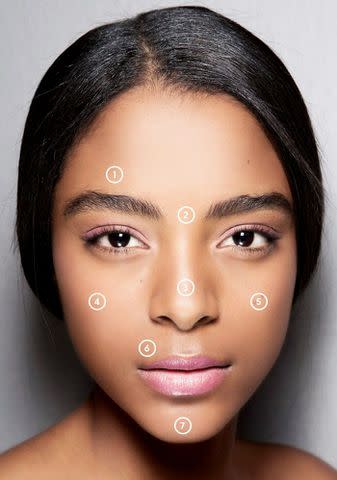Acne Face Mapping: Can Your Breakouts Provide Clues to Your Health?

Stocksy
Fact checked by Anna HarrisReviewed by Julia A. Siegel, MD
Have you ever wondered why you sometimes break out in very specific parts of your face? Maybe your breakouts tend to be concentrated on your jawline, or on your forehead—yup, that's what people have called the acne face map. For centuries, people have turned to the theory of face mapping—the idea that different parts of your face are associated with different organs or body parts and that if you heal those areas, your skin will clear up from the inside out.
Intrigued? We were, too. That’s why we consulted three doctors— acupuncturist, Daniel Hsu, and dermatologists, Rachel Nazarian and Onyeka Obioha— to get the full story on face mapping: where it comes from, how it works, and how you can use it to diagnose causes of different facial breakouts.
Meet Our Expert
Daniel Hsu, DAOM, LAc is a doctor in New York, NY who specializes in acupuncture and Chinese medicine. Hsu serves as the team chair for the Accreditation Commission for Acupuncture and Oriental Medicine.
Rachel Nazarian, MD, is a board-certified dermatologist and fellow of the American Academy of Dermatology. She specializes in cosmetic treatments, skin cancer, and dermatologic surgery.
Onyeka Obioha, MD, FAAD, is a board-certified medical and cosmetic dermatologist in Los Angeles, CA. She specializes in acne, hyperpigmentation, scarring, and hair loss.
What Is Acne Face Mapping?
Acne face mapping is an ancient practice rooted in Ayurveda teachings and Chinese medicine that treats your face as a road map to pinpoint underlying issues in other parts of your body. “Face mapping goes back thousands of years,” says Dr. Hsu. “A lot of it comes simply from clinical experience. Nowadays, you have all types of blood tests and scans, but back then, doctors would have to give a diagnosis by looking, touching, and asking questions.”
Chinese medicine states that all organs have a different color, temperature, and taste, and are manifested in a certain way. According to traditional Chinese medicine, the liver, for example, is manifested in the eyes. In fact, one of the first symptoms of jaundice (a liver disease) includes yellowing of the eyes: “That was true 2000 years ago, and it’s still true today,” Dr. Hsu says.
Dr. Nazarian agrees that location-based breakouts are a common issue, explaining that “we do see certain trends that may create patterns of acne breakout on specific areas of the face such as female hormonal acne presenting as lower face and neck pimples.” However, she encourages patients who use face mapping to combine this treatment style with approaches that are more focused on the lesions themselves (rather than relying only on their location to inform treatment).
“You should treat your face with an individualized approach, unique from everyone else. Ultimately, the same cause can present as different distributions of acne on different people. Some people break out on their cheeks with stress, others on their forehead or even their back. Again, the type of acne is more important than the area,” says Dr. Nazarian.
How Does Acne Face Mapping Work?
Dr. Hsu says that the quality of the skin on your face provides an expression of your health. “The body is made up of a bunch of systems—lymphatic, neurological, digestive, to name a few—and all of these systems are tied together,” he explains. “It’s very difficult to affect one without affecting others.”
Hsu also states that face mapping is a way to verify what’s going on inside your body, since all parts of your body (including organs) are interlinked. “In Chinese medicine, we look at the body as a whole and how everything works together,” he says.
Dr. Obioha points out that, from a strictly scientific, dermatological perspective, “there is no [direct] evidence that breakouts on the skin correspond to imbalances of internal organs.” That said, she does believe that “there are certain patterns of facial breakouts that [offer] clues to breakout triggers.”

Reading the Acne Face Map
Above the Brows
According to Chinese medicine, the area above your brows is linked to your gallbladder and liver. If you’re getting breakouts there, try eating less processed or junk food and reduce the amount of fat in your diet.
For more useful tips on banishing your forehead acne, follow this advice from Dr. Obioha: “For forehead breakouts, switch to oil-free hair care products. Also, most people tend to wash their face first, then apply hair products afterward. These products can drip down onto the forehead and clog pores. I always advise my patients with forehead breakouts to do the reverse: Apply hair products first, then wash your face to prevent buildup on the forehead from the scalp.”
Between the Brows
Dr. Hsu says that breakouts between your brows might mean that you’re drinking or smoking too much, or eating too many rich foods. “Cut down on rich foods, butter, cheese, and late-night snacks,” he advises. “Incorporate more exercise into your routine, and get more sleep.”
Nose
Your nose, in the face mapping canon, is connected to your lungs and heart. To combat breakouts in this area, Dr. Hsu recommends cutting back on spicy foods, meat, and salt and replacing them with fruits, veggies, and nuts (which are full of healthy fats like omega-3 and omega-6). If you’re getting constant breakouts on your nose, you might want to check your blood pressure and vitamin B levels; Dr. Hsu says that upping your vitamin B intake can help combat flare-ups.
Also, Dr. Nazarian mentions that “certain areas tend to have classic acne lesions; [for example,] the forehead and nose often have small blackheads and whiteheads. Medications containing retinoids are the ideal type of [treatment for these blemishes].”
Left Cheek
“Chinese medicine is really big on left and right,” Dr. Hsu tells us. If you’re breaking out on the left side of your face, he recommends eating what Chinese medicine practitioners refer to as “cooling foods”—think winter melon, cucumber, and the like. He also says that the left cheek is more connected to your liver, which, according to Dr. Hsu, operates at its weakest between 1 p.m. and 5 p.m. “If you’re having a breakout on your left cheek, try to avoid any strenuous work during that time of day,” he advises.
There could be another common cause for persistent cheek acne, and Dr. Obioha spells it out like this: “[If you’re experiencing] cheek breakouts, make sure to wipe down your phone screen multiple times per day and/or to opt for headphones to prevent buildup of oil and bacteria on the face. Also, over-the-counter cleansers with 2 percent salicylic acid [can] penetrate deep into oil glands and unclog pores, [making them] helpful for preventing buildup.”
Right Cheek
Dr. Hsu says that the right-side cheek has a connection to your lungs. He suggests doing aerobic and breathing exercises early in the morning to strengthen your lungs (and to improve the acne situation on your right cheek). Dr. Hsu also claims that the right cheek responds more strongly to sugar than other parts of the face, recommending that, “if you’re breaking out on your right cheek, [you should consider] cutting back on junk food and sugar, as well as wine and seafood.”
Mouth Area
If you suffer from breakouts around your mouth area, your diet could be partially responsible. Chinese medicine says the area around your mouth is associated with your digestive organs, like your intestines and liver. Dr. Hsu supports cutting back on spicy foods and fried food while eating more fiber, fruits, and veggies.
Chin
“Modern acupuncturists would say that if you break out around your chin, you should get your hormone levels checked,” Dr. Hsu says. “Stress can also be a huge part of it.” Dr. Obioha concurs, adding that “breakouts on the lower third of the face (cheeks, chin, and jawline) point to hormonal acne. Hormonal acne flares up around the menstrual cycle and can occur with or without underlying hormonal abnormalities such as polycystic ovarian syndrome (PCOS).”
To ease these breakouts, Dr. Hsu suggests drinking spearmint tea and taking omega-3s, as well as talking to your doctor about your hormone levels. It's also crucial to visit a board-certified dermatologist if you're experiencing moderate to severe breakouts, as there are a number of prescription treatments that can drastically improve breakouts and prevent scarring.
The Final Takeaway
Even in today's modern world, the ancient practice of face mapping is still relevant. Along with Western medical science, the connection between organ health and skin health that is the foundation of face mapping may provide useful information for anyone struggling with stubborn breakouts—providing another piece of the puzzle when creating a holistic treatment plan for healing your skin. Although most dermatologists wouldn't say that face mapping is foolproof nor should it be the only way you approach your acne, it can be another piece of the puzzle as you try to determine why you're breaking out.
Up Next: How to Know Whether Your Breakout Is Actually Folliculitis
Read the original article on Byrdie.
